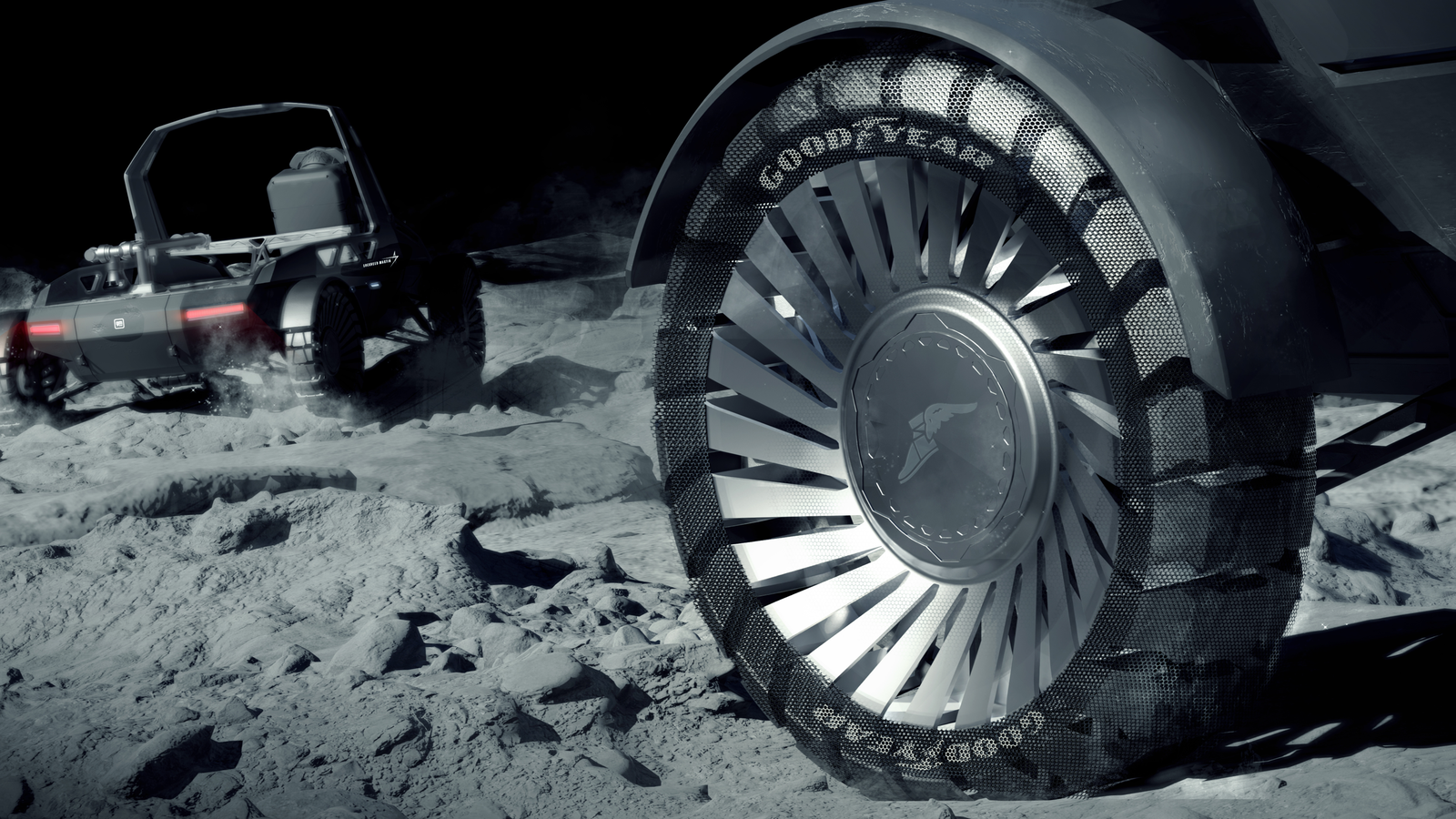How Do You Change a Tire on the Moon?

When the new lunar mobility vehicle takes its first spin around the moon, it will be sporting a familiar logo on its wheels: Goodyear’s. But unlike the tires on your car, the lunar vehicle’s will be airless, made entirely of metal and clad in mesh.
Yet, the lunar tire isn’t entirely a separate beast, according to Goodyear Senior Program Manager for Non-Pneumatic Tires Michael Rachita. The tires might be rolling around the moon, but they are closely related to some Earth-bound technology—and will help that technology evolve even further.
- Rachita chatted with us recently about Goodyear’s contributions to the lunar mobility vehicle, which is being designed and built by Lockheed Martin and GM for deployment later this decade (read our interview with Lockheed Martin Vice President for the Lunar Exploration Campaign Kirk Shireman).
- It is intended to stay on the moon for years, both supporting NASA missions and functioning autonomously when the astronauts are not around. Here’s what Rachita told us about the tires that will make it all possible.
The design: A traditional rubber tire simply wouldn’t work on the moon, Rachita explains. It wouldn’t hold its air pressure in the vacuum of space, and without an atmosphere to filter out the sun’s radiation, the rubber would quickly degrade.
- Instead, Goodyear will be using metal alloys, such as aluminum and special steels. As Rachita puts it, “You can tap into the standard materials that are used in satellites as a starting point”—materials that are already tried and tested for space.
The environment: These are some of the environmental factors that engineers must consider, says Rachita.
- Temperatures: The moon undergoes extreme transitions in temperature, ranging from -280 degrees Fahrenheit at night to 260 degrees Fahrenheit during the day.
- Gravity: At only 1/6th that of Earth’s, the moon’s gravity changes the calculation of flexibility. The metal tires act something like a spring, but since objects bear down with much less weight on the moon, the tires must be correspondingly more flexible than they would have to be on Earth, Rachita says.
- Moon dust: The lunar regolith is sharp, abrasive and electrostatic, says Rachita, and acts something like very soft sand. In designing these tires, Goodyear has taken inspiration from off-roading techniques used for sandy or rocky areas, such as deflating tires to create a soft, broad surface that almost floats over the landscape.
The tests: Some of the testing is familiar, including sessions on a traditional flat track at Goodyear’s headquarters in Akron, Ohio. The track has a rotating band like a treadmill, which the testers must slow down, as the rover will top out at 12 mph (for safety reasons). The engineers can still learn a lot from the tires’ behavior even in Earth’s gravity, Rachita says.
- For other tests, however, the company has had to “create an event,” he says. That includes finding facilities with cryogenic chambers to test the tires’ durability in extreme temperatures.
- To mimic the lunar surface, the company will use soil rigs filled with simulated lunar soil developed by NASA.
The big question: Rachita responds to our inevitable question—“How do you change a tire on the moon?”—with a simple answer: you don’t.
- In fact, he adds, the technology that gives these tires a high degree of redundancy—allowing them to sustain damage and still keep going—has important applications here on Earth.
- “This is where it all connects for Goodyear and its strategy,” he says.
A tire revolution: Goodyear is working to make products that are “maintenance free,” Rachita explains, which is essential to new developments in mobility. Airless tires have an enormous advantage for both electric and autonomous vehicles, he says.
- First, electric vehicles have far fewer parts to maintain (like spark plugs and oil systems), so it makes sense to eliminate another source of frequent maintenance—air-filled tires.
- Meanwhile, if an autonomous vehicle gets a flat, who’s going to fix it? As Rachita says, often no one will be around; AVs will spend a lot of time traveling without passengers to their next pickup points.
- Air-filled tires don’t have redundancy, as Rachita points out—you get a flat tire and it’s an immediate problem. But on an airless tire with a “tension bridge” that supports its structure, up to 20% of the spokes can break without requiring a change. And if the mesh covering the tire tears, you don’t immediately start losing all of the air inside it.
Just in case . . . The lunar mobile’s tires will be attached rather traditionally, with either multiple lugs or one lug (as found on racecars)—so they could technically be changed on the moon. But the plan is to ensure this never becomes necessary, says Rachita.
The last word: Creating tires for a long-lasting lunar vehicle is a “challenge to engineering thinking,” as Rachita puts it. It’s the sort of challenge that will pay off for the rest of us, too.
